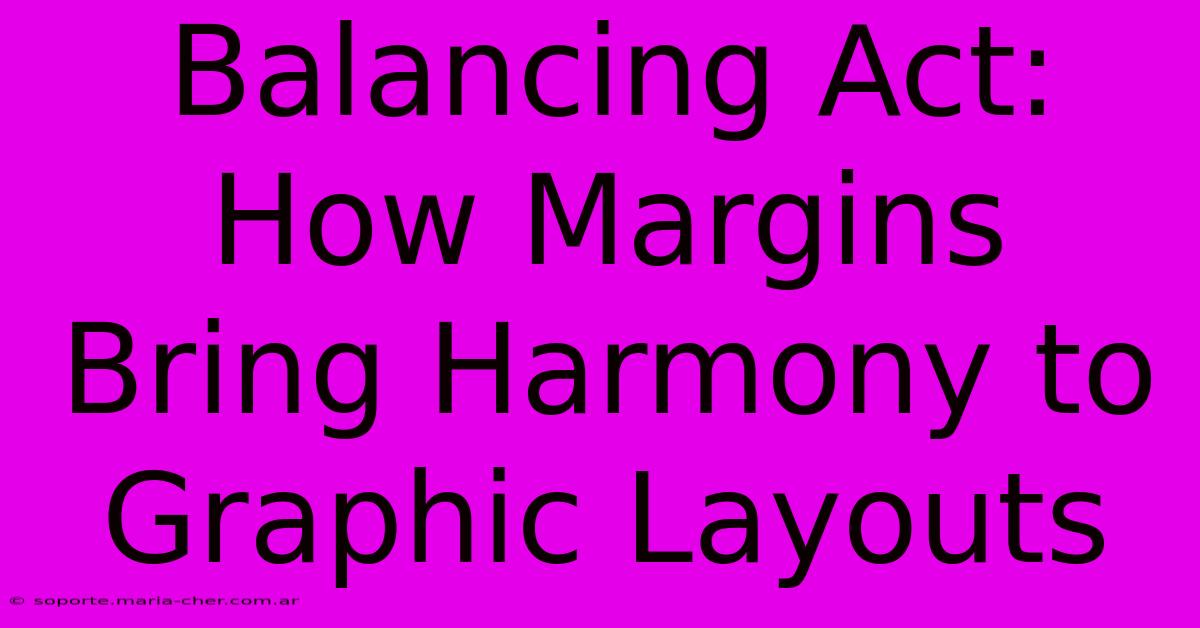Balancing Act: How Margins Bring Harmony To Graphic Layouts

Table of Contents
Balancing Act: How Margins Bring Harmony to Graphic Layouts
Creating visually appealing and effective graphic layouts isn't just about choosing the right fonts and colors. It's about the subtle, yet crucial, element that brings everything together: margins. Often overlooked, margins are the unsung heroes of good design, providing the breathing room that allows your design elements to shine. This article explores the importance of margins and how mastering them can elevate your graphic design to a whole new level.
Understanding the Power of Margins
Margins are the blank spaces surrounding the elements within a design. They might seem insignificant, but they significantly impact the overall aesthetic and readability of your work. Think of them as the frame around a beautiful painting – they enhance the artwork, not detract from it.
Key Roles of Margins:
-
Improved Readability: Sufficient margins prevent text from feeling cramped and overwhelming. They guide the reader's eye, creating a clear and comfortable reading experience, particularly important for print designs like brochures or books.
-
Visual Hierarchy: Strategic margin use establishes a visual hierarchy, guiding the viewer's attention to key elements. Larger margins around certain components emphasize their importance, while smaller margins create a sense of unity for related items.
-
Enhanced Aesthetics: Margins create visual breathing room, preventing the design from feeling cluttered or chaotic. They add balance and harmony, allowing individual elements to stand out and contribute to a cohesive whole.
-
Professionalism: Consistent and well-defined margins convey professionalism and attention to detail. This is crucial for branding materials, marketing collaterals, and other design pieces that represent your business or client.
Mastering Margin Techniques:
The key to successful margin use is understanding different margin types and how to apply them effectively.
Types of Margins:
-
Inner Margins (Gutters): The space between columns of text or elements in a multi-column layout. Consistent inner margins ensure even spacing and improve readability.
-
Outer Margins: The space between the design elements and the edges of the page or screen. These set the overall tone and feel of the design.
-
Micro Margins: Very small margins used to create subtle separation between elements within a group. These are effective for creating a sense of visual order and reducing clutter in complex layouts.
Practical Tips for Effective Margin Use:
-
Consistency is Key: Maintain consistent margins throughout your design for a polished and professional look. Inconsistent margins create visual dissonance.
-
Consider the Medium: Margins should be adjusted based on the medium (print vs. digital). Print designs often require larger margins to account for binding and printing limitations. Digital designs are more flexible.
-
Experiment with Ratios: Explore different margin ratios to find the balance that best suits your design. The "golden ratio" (approximately 1:1.618) can be a helpful guideline, but experimentation is crucial.
-
Use Grid Systems: Grid systems provide a structured framework for placing elements and ensuring consistent margins across the entire layout.
-
White Space is Your Friend: Don't be afraid to embrace whitespace. It's a powerful tool for creating visual breathing room and highlighting key elements.
Beyond the Basics: Creative Margin Applications
While consistent margins are essential, don't be afraid to experiment with asymmetrical margins or unusual layouts to create unique visual effects. Asymmetrical margins can add dynamism and visual interest, drawing attention to specific areas of the design.
Conclusion: The Harmony of Balance
Mastering margins is a critical skill for any graphic designer. By understanding their role and applying the techniques discussed above, you can create graphic layouts that are not only visually appealing but also highly effective in communicating your message. Remember, the seemingly insignificant space created by margins significantly impacts the overall harmony and effectiveness of your design. It's the subtle dance of balance that transforms a good design into a great one.

Thank you for visiting our website wich cover about Balancing Act: How Margins Bring Harmony To Graphic Layouts. We hope the information provided has been useful to you. Feel free to contact us if you have any questions or need further assistance. See you next time and dont miss to bookmark.
Featured Posts
-
Son Of Mj Marcus Arrested Dui
Feb 05, 2025
-
No Excuses We Re Sorry For The Mess But Heres How We Re Making It Right
Feb 05, 2025
-
Premiership Stars Tragic Passing Confirmed
Feb 05, 2025
-
Master The Art The Essential Elements Of A Winning Ux Design Portfolio
Feb 05, 2025
-
Gabbards Intel Chief Nomination Moves Forward
Feb 05, 2025
